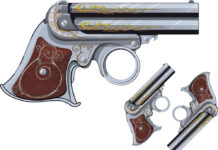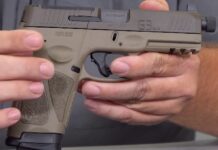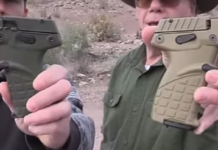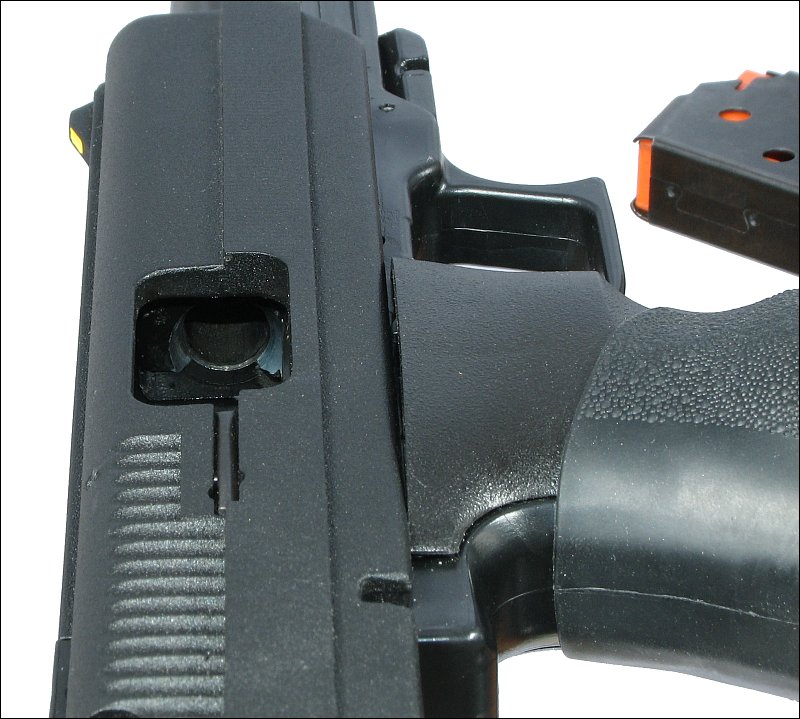I recently read a story where a civilian who was concealed carrying fought back against an armed bank robbery and won. He shot the guy 3 or 4 times and the armed robber didn’t shoot back once, instead, he turned and ran out of the bank before collapsing.
That’s not the surprising part …
The surprising part is that the civilian was carrying without a round in the chamber (sometimes referred to as “Israeli Carry” for reasons I’ll explain in a moment).
So, does that mean that you should not carry a handgun with a round in the chamber?
Is it safer?
Here’s the story …
What is Israeli Carry?
So called “Israeli Carry” is another name for “Condition 3” carry. In short, there is no round in the chamber, the hammer is uncocked but a fully loaded magazine is inserted in the mag well.
That means that before you can shoot the gun, you have to rack the slide to chamber a round.
It’s called Israeli Carry because the Israeli military apparently used to teach it along with a standard curriculum on how to draw, rack and fire a first shot.
The technique/doctrine actually has its roots in the time period when the autoloading pistol was first developed …
From about 1907 to 1940 when Fairbairn and Sykes were working with the Shanghai Municipal Police they even made it a part of their curriculum.
Shanghai was a cesspool of crime from the Opium trade and fights with Triads were common for the police. After teaching those police, these are the same men who were recruited by the British Secret Service to develop the training for the British Commandos for the world war. When the US needed a similar training program for the OSS, they taught many similar methodologies from this lineage through Col. Rex Applegate.
Then it spread around the world, and Israeli somehow became the most recognizable military that used it. I’m not sure but I’m guessing that’s because they were still using it for the longest period of time (up until about 20 years ago).
Condition 1 (carrying with one in the chamber, cocked and locked) became the dominant method of carry when Jeff Cooper pioneered the so called “modern technique” later on.
Why Do Some People Not Carry A Loaded Gun
Quite simply, I think that most people don’t feel “Safe” with a loaded gun.
The idea of walking around with one strapped to their hip makes them nervous.
They think the gun could go off and accidentally shoot themselves or someone they love because it’s “cocked and locked”.
Let me go ahead and get something out of the way now …
When I First Carried a Gun, Having It Loaded Made Me Nervous
It actually did.
I had this fear that the gun would just “go off” simply because it was loaded. After all, the gun is loaded, so couldn’t the firing pin fail or something and just fire accidentally?
The truth is, learning the facts eased my mind.
You see, with modern guns, this simply doesn’t happen. The first gun I carried was a DA/SA Sig P225. That means that the first trigger pull was extra long (and heavy because it was actually a P6 German Police model gun) and it simultaneously cocked the hammer and THEN fired it.
It’s impossible for a Double Action pistol to “Go off” by itself unless you pull the trigger.
The gun I switched to, and now still carry, is a Glock 19 Gen 4 which is striker fired. There are no “external safeties” with the Glock pistol, so you would think that keeping it loaded is dangerous and that it could “fail” and the gun would just go off. But that’s not true either because the Glock was designed with multiple, redundant internal safeties they call their “Safe Action System”.

There’s the trigger safety, the FIRST in the series of 3 devices that must be engaged for the gun to fire.

If the trigger safety is not depressed, the trigger will not move rearwards and allow the pistol to fire.
Then there is the spring loaded Firing Pin Safety.

The spring-loaded firing pin safety projects into the firing pin channel and mechanically blocks the firing pin from moving forward. When the trigger is being moved rearwards, a vertical extension of the trigger bar pushes the firing pin safety upwards, clearing the firing pin channel. During the slide cycling process, the firing pin safety automatically reengages.
And lastly, there is the drop safety.

The rear part of the trigger bar, which has a cruciform shape, rests with both arms on the drop safety shelf located in the trigger mechanism housing. When the trigger is pulled to the rear, the trigger bar begins to move down off the shelf until finally separating from the firing pin lug. During the slide cycling process, the trigger bar is lifted and caught by the firing pin lug. The trigger bar is reengaged by the firing pin lug.
Essentially, you HAVE to pull the trigger for the gun to fire. It simply can NOT just go off due to the three safety measures.
This is NOT me bragging on Glock about how amazing their safety system is, but what I want you to understand is that modern handguns are extremely reliable and well made and generally have redundant safety measures like “drop safeties”, etc
Once I realized that a modern, loaded gun simply can not mechanically fire unless the trigger is depressed I became much more comfortable at carrying a loaded gun.
That and I actually forced myself to just carry the thing loaded. Do anything, enough, and you will grow comfortable with it in short order.
Why Condition 3, Carrying On An Empty Chamber, Is Obsolete Now (Just Like Point Shooting)
The truth is that carrying on an empty chamber was developed in a time when handguns simply weren’t mechanically reliable.
Further, it was developed and promoted by people who had to train a LARGE amount of “wet behind the ears” recruits quickly and safely to use a handgun.
It’s important to keep in mind that this was also the time period when “Aimed Fire” was thought to not be effective. In short, everyone was taught to “point shoot” (not using the sights) and shoot one handed most of the time too. The Fairbairn book is actually called, “SHOOTING TO LIVE WITH THE ONE-HAND GUN” because during this time period it was accepted doctrine that handguns were fired with one hand, and not aimed with the sights.
I actually have a friend that is Israeli and served in the military during that time and later became a firearms instructor (he also wrote a few articles for gun magazines).
I asked him about Israeli Carry and referenced an 80’s video on the method and point shooting and here’s what he said:
“… the system–and my opinions–have evolved since that video was made, around 20 years ago. For example, a lot of Israeli instructors used to be very doctrinaire about not carrying a bullet in the chamber. This makes sense in certain circumstances, and was very logical in Israel at the time, and even now to some extent. (I can explain, but it’s probably boring.) By contrast, in the US, this is less practical and I advocate carrying with a loaded chamber in nearly every circumstance.
The grip, stance and maneuvering are all pretty much the same. While they don’t look pretty, they are based soundly on human physiology and very well-vetted over many, many conflicts.”
Of course, I did not think it was boring and wanted to know every detail. So I got him to tell me more …
“In the earlier years of Israel, a lot of people were called to arms for security duty, but had little or not training with gun handling and marksmanship. To complicate matters more, there were multiple handgun models circulating around the various security forces. So one reason for the condition 3 carry was to get everyone up to at least a minimal level of skill as quickly and easily as possible.
“Carrying chamber empty means every semi auto operates in exactly the same way, whether single or double action, with or without manual safeties. So one single method could be taught that would work on all handguns. It also makes all modes of carry equally safe. (Holstered, tucked in waistband, “thunderwear” carry, etc.)
“Particularly with people who aren’t inclined to or even able to train a lot, condition 3 is the safest mode of carry. There is zero chance of a negligent or accidental discharge while carrying. So this is yet another advantage.
“Utilizing the Israeli method properly also causes the gun to be seated in the web of the hand, almost insuring an excellent grip on the handgun.
“So there are definitely reasons to carry condition 3.
“Having said that, Israel’s particular security threat is markedly different from ours. In Israel, at least when I lived there, there was virtually NO violent crime. (As an aside, it’s quite common to see soldiers on leave in line at places like the bank, with an assault rifle slung over their shoulder. You take your weapon home with you in the Israeli military, so often these guys aren’t even in uniform.)
“In the States, the primary reason to carry a firearm is protection against violent crime. Specifically violent crime in which you are the intended target. Contrast this with a generalized terror threat in Israel, and the distinction is obvious; Terrorists target groups of individuals, and are more readily identifiable. So in Israel, (like the States) you may be one of many who are armed on the street. But you may need to get your weapon into action to address a threat that is more distant from you than a typical violent crime. (Like if a terrorist is shooting into a crowd, or attacking someone with a knife, etc.)
“In the US, the most likely situation to draw and fire your weapon is during an attempted violent crime, such as a rape or robbery. Frequently, this involves one or more aggressive males crowding and focusing on a single individual. The dynamic is different, and I simply feel better prepared (after LOTS of practice!) carrying my firearm condition 1. ”
Now, when you see where the method gained popularity … and why it was developed … it makes more sense.
Does that mean it’s right for you?
Why You Should Keep Your Self Defense Gun Loaded
First, modern handguns are extremely MECHANICALLY safe. Almost all service caliber, sub-to-mid-size guns by the reputable gun manufacturers can be loaded and will NOT fire unless the trigger is depressed. They almost all have drop safeties and other redundant safety features.
That means the only variable when it comes to safety is you which is why it’s so important to follow the firearms safety rules.
Second, if you carry your gun in a holster that covers the trigger guard and trigger, then the ONLY risk is essentially getting the gun into the holster without touching the trigger. Once it’s in the holster, it should be impossible to fire.
Third, while you can carry with an empty chamber. Why would you?
The potential downsides are too great in my mind …
1. Racking the slide takes extra time
2. Racking the slide (usually) takes two hands. Whenever possible you want both hands on the pistol as quickly as possible for the best gun control.
3. Racking the slide is adding ANOTHER thing you have to do to successfully get the gun out of your holster, on target and shoot. In other words, it’s another thing that you can (and most likely will) mess up under stress.
The data shows that most gunfights happen in 3 seconds or less.
IF you think that carrying with an empty chamber is correct for you, then I encourage you to go to the range and see if you can draw from your every day carry concealment and rack the slide and make an acceptable (anatomically valuable hit) on the target in less than 3 seconds.
If you get a friend to time you, or set a timer on your cell phone, or set a par time on a shot timer — I think you’ll be surprised.
Just a little bit of stress can make it very easy to mess up even simple things like even moving a shirt out of the way to grab your gun and draw it. Adding more things to do is simply silly. In fact, that’s one of the benefits of carrying a gun without a manual safety (like a Glock but we’ll cover that at a different time).
What are your thoughts? Do you ever carry or store your gun with an empty chamber? If so why?










![What Level Holster Should You Be Using? [Video]](/wp-content/uploads/2024/04/Depositphotos_44548439_S-218x150.jpg)
![Case Study: Defensive Gun Use [Video] NSFW](/wp-content/uploads/2025/07/Depositphotos_282075792_S-218x150.jpg)




















![Optic Ready vs Milled slides? [Video]](/wp-content/uploads/2024/02/image-3-100x70.png)
![[Checklist] What Gear You Need To Take Pistol, Rifle & Shotgun Training Courses [Video]](/wp-content/uploads/2023/07/Depositphotos_275087632_L-100x70.jpg)
![What is in Carter’s 2023 EDC? [Video]](/wp-content/uploads/2023/07/Depositphotos_146856137_L-100x70.jpg)



Carrying in condition 3 also makes it possible that you may drop your gun while trying to cock it quickly (Especially if you have small hands) and the noise made cocking the slide back and forward makes a well recognized sound that will get the perpetrator to shoot you first when he may Not have shot at all otherwise during his bank robbery ? ! If he did Not hear you racking one into the chamber.
I carry a 1911 and as a rule I carry condition 2 (hammer down on a live cartridge). I find it just as fast to thumb the hammer back as it is to disengage the safety
In order to carry a 1911 in condition 2 you must violate one of the premier rules of firearms safety: “keep your finger off the trigger until you are ready to shoot”. The only way to put the firearm into condition 2 is to depress the trigger and ride the hammer down. That is begging for a negligent discharge. As a certified firearms instructor I strongly urge that nobody do this.
I strongly agree! The 1911 was not made to be carried in such a way, if you want to carry with the hammer down and loaded get a modern firearm with a decocker. I know people who have caused a negligent discharge with a 1911 trying to do this. Do not do it. I’ve seen people lose hands to this method.
Carrying in condition 3 also makes it possible you may drop your gun while trying to cock it quickly (Especially if you have small hands) and the noise made cocking the slide back and forward makes a well recognized sound that will get the perpetrator to shoot you first when he may Not have shot at all during his bank robbery ? ! If he did Not hear you racking one into the chamber.
I had been carrying my gun with an open chamber. But after reading your article, carrying with a round in the chamber makes sense. I can see where carrying with a round in the chamber will save you several seconds to put a round in the chamber. I have not timed this but if carrying in the chamber gives you three or four less seconds then it will make a difference on whether you drop the bad guy or whether you go to your grave. I would rather have the drop on the bad guy. This not only makes sense but will Dave your life.
I have 4 different 9mm handguns, Sig Sauer P229, Smithson Wesson SW9VE, Ruger LC9, and a Makarov made in Russia. The sig Saure and Makarov have an exposed hammer which I can but in half cocked, the SW, and Ruger do not. My question is having the internal hammer for the SW, and Ruger wouldn’t that weaken the spring over time, so when I am at home the Sig is right next to me at all times, but when I go out I’ll carry one of the other weapons and will have a round chambered.
No, never in 45 years. A gun is a tool if you know how to use a tool why would you turn it on before you were ready to use it? If you say mistakes happen, well then you need to look at the mechanics of what it takes to fire a weapon. You need to stick your finger inside the trigger Guard and pull it , to fire the gun. If the trigger guard is covered you can’t do this unless you either choose to, or are a very clumsy person, in which case having a gun is a risk to begin with. I think that trying to rack a round in the heat of a gun battle is far more a recipe for disaster than pulling the trigger in a holstered weapon.
You need to get over the fear of thinking you are going to screw up, the chances are that you will never be paying more attention to what you are doing than at the time of a crisis.
You will never be paying more attention to what you are doing than during a gunfight. If you are that clumsy, you will make a mistake racking the side and have no need to worry about a loaded gun.
Reasonably complete discussion of the primary topic (round in chamber or not).
But then – –
Why the gratuitous slam against point shooting, impugning it as obsolete? What do you know about point shooting? What do you know about nationwide police accuracy stats in lethal force incidents? All those misses are by officers trained for aimed fire. The *slam* on point shooting is not valid.
lewis, I just went through a class with my local PD, and they told us that the nat’l avg for LEOs hitting their intended target is 11%, caused by the stress of the situation. Thomas, are you asking about the spring in an LC9? I also have an LC9 as my EDC gun. It is a DAO, so there’s no worry about wearing out a spring by carrying it with a round in the chamber, as I always do.
My first thought about Condition-3 carry has to do with a scenario where an assailant gets control of your semi-auto before you’ve had a chance to rack the slide.
It’s likely the typical assailant will assume the weapon is ready to shoot. Until he figures out he cannot fire, you have the advantage of knowing you’re relatively safe. You can use the ensuing delay brought about by his failure, confusion and consternation to attempt to retrieve the weapon without getting shot.
So carry without one in the chamber because you had the gun taken away from you 1x times … so you think the confusion caused when he tries to shoot you with your own gun is empty … will allow you to get the gun back again.
I believe this does not apply to revolvers? I have hunted with my Smith 44 mag and Colt 357 mag. And I always had the hammer resting on an empty cylinder!
Of course these animals could not shoot back so in a gun fight I would have one less round to fire but I think it is better to be safe than sorry.!
Your thoughts!
Vince
Yeah the article is about semi-autos.
If you have say a Ruger Old Model Blackhawk, carry with an empty chamber under the hammer in case the hammer gets struck a heavy blow. It doesn’t change the fact that the cyllinder is going to turn anyway when you cock the hammer. Just remember you only have only five rounds instead of six. The New Model Blackhawks have a transfer bar that’s intended to prevent a blow to the hammer from firing a round because that transfer bar keeps the hammer from contacting the firing pin except when the trigger is pulled.
If you have say a Ruger Old Model Blackhawk, carry with an empty chamber under the hammer in case the hammer gets struck a heavy blow. It doesn’t change the fact that the cylinder is going to turn anyway when you cock the hammer. Just remember you only have only five rounds instead of six. The New Model Blackhawks have a transfer bar that’s intended to prevent a blow to the hammer from firing a round because that transfer bar keeps the hammer from contacting the firing pin except when the trigger is pulled.
No S&W revolver made in at least the last 50 years can be made to discharge without pulling the trigger.
I carried for a long time with empty chamber, but discovered that undoing the “safety”., the lever that allows you to drop the hammer safetly, works really hard, and in a panic state, I doubt that I could even get it off safety, it works so hard. I now carry a round in chamber, but the hammer down to the little lock just above the bullet. I also notified my cleaning lady that if she comes across any of my guns, Remember! There is a round in the chamber and no safety!! she’s the only one that is ever in my house when I may not be home at the time!
Having served as a police officer for 22 years and retired for 23 years I can honestly say the only way to carry is with a round in the chamber. When something bad happens the less you have to think about the better off you are. Unless you physically pull the trigger your weapon is “not” going to go off. The time it takes for you to rack your slide is going to put you in an early gravesite.
Actually, point shooting was good in its time, and still is, but now that laser sights are so common, (and cheap), it’s pretty efficient to do the one-handed draw, use the weak hand to activate the laser, (assuming you don’t have a “squeeze pad” switch) as you set the hand for support, and just lay the dot on the target. And, if you use a modified Weaver stance, you’ve got your weak arm covering a good part of your kill zone, your cheek tucked against your shoulder a la rifle, and your weak arm making a triangle for a good, rigid position. Just my opinion, but it works for me.
The reality is that if you pull a firearm on someone before they attack you, you wind up being the bad guy and the legal system will cut you no slack no matter how menacing the three guys (soon to be fine upstanding college students I’m sure) surrounding you appeared to be. Nobody will admit they were going to attack you if you pull a firearm before they do. If you wait to be attacked, there is a good chance you will be fending off an attacker with your left arm as you pull your firearm with your right – AND AT THAT POINT YOU BETTER HAVE A ROUND IN THE CHAMBER!!! (Train to fight as well as shoot)
I was at a flea market one day some years ago and had a 1911 in a Yaqui holster in Condition One, cocked and locked. A blue-haired little old lady approached me and pointed at my sidearm and asked, “Isn’t that dangerous?” I smiled and said only for people who try to attack me. It apparently satisfied her, so she went her way. John Moses Browning designed what came to be known as the pistol, US, .45 ACP. Loaded, a round in the chamber, hammer back and safety engaged. I never completely trusted mechanical safeties, as firearms are designed and built by human beings, an admittedly imperfect species, and it is lunacy to expect perfection from an imperfect species. the very best, most reliable safety is between the shooter’s ears. If the shooter is properly trained and follows the safety rules of firearms, he/she is perfectly safe with a loaded weapon.
It actually depends for me on the side arm I am carrying and where I am. If I’m in shady parts of town, I’m always condition 1. Otherwise I am comfortable with condition 3. Double action weapon, one in the chamble and hammer at rest just like a revolver.
What if you start out in the “nice” part of town and unexpectedly have to go to the “shady” part? Do you draw your gun, rack the slide, maybe top off the magazine, and reholster it?
And what exactly constitutes the “shady” part of town? Is it where “those” people live? “Those” people have cars, too, or they can ride the bus, and get to the “nice” part of town, where the victims are more likely to have cash and less likely to have guns.
One thing you didn’t mention about condition 3 carry. Back in the late 50s and early 60s, we Navy guys had some armed guard stations, where the Colt 1911 then in use was attached to the guard post, not the individual Sailor. Protocol at the change of the watch was to draw the weapon, drop the slide, then rack and pull the trigger, to drop the hammer. The person assuming the watch, after putting on the belt and holster, inserted the magazine in the weapon and holstered it. Aside from being the safest method for those who did not carry every day, as you mentioned, this avoided constantly chambering and unloading a round, then inserting it into the magazine several times a day. Eventually, that round is going to suffer from set back from this repetitive loading and unloading. If it was fired after set back, you can imagine the increase in pressure upon discharge, with the possibility of failure of the weapon, not to mention the accidental discharge this method may lead to from dropping the mag, then forgetting the round in the chamber. While on the base police in Cuba, we did carry in condition 1. One of the troops holed the ceiling when he got his steps confused in making his weapon “safe” when going off duty. Makes a pretty loud noise in a small guardroom!
Another consideration: Back in the late 50s and early 60s, we Navy guys had some armed watch stations. The weapon, then a Colt 1911, was attached to the guard post rather than to the individual. The watch was manned with the pistol in Condition 3. Protocol at the change of watch was to drop the magazine, rack the slide to show the chamber was empty, pull the trigger on the empty chamber, then hold the pistol while the relief guard donned the belt and holster. He or she was then given the weapon and magazine. The magazine was inserted and the pistol holstered. Their were two reasons for this: One, the safety of those who did not carry every day. Two, the possibilty of setback of the bullet in the cartridge from constantly being chambered and reinserted in the magazine several times a day. If that round was fired, you can imagine the possible damage from the increased pressure of that round. While on the base police in Cuba, we did carry in Condition One. This was during the Revolution, and Castro’s rebeldes were prone to slip into the base to steal what they might find useful. One of our troopers holed the ceing when he got the steps confused when making his weapon “safe” when going off duty. Made quite a noise in a small guardroom!
As a law Enforcement officer for three large Metropolitan police departments, with (45) yrs. experience in uniform, plain clothes & detective work, ie. NY C, I usually carried a double action revolver,or an automatic pistol (single & double action, plusadouble action snub nosed revolver ) , usually unlocked, with a
Live round in the chamber, without incident, always ready for use; only once, when carrying a .357 derringer (over & under, while working Plain clothes detail,
Did I have the hammer resting on a loaded round, until I realized that the firing pin caused an indentation on the primer, causing me to immediately dispose of the derringer, considerations myself lucky that it Haden’s gone off. it was a poor quality, of dubious make.
you get what you pay for
Thanks for chiming in!
A weapon without a round in the chamber is nothing but a pipe with a handle on it.
The numbers speak for themselves, you are far more likely to have a accidental or negligent discharge than you are to need that 1 second to rack and chamber. How many people have been shot with their own firearm because it was in Condition 1? Too many for me. It has nothing to do with mechanical reliability, it everything to do with the risk. You can exponentially reduce the risk by carrying in Condition 3.
I have trained with 8 Israeli instructors and operatives in recent years. All of them explained that the empty chamber carry came from the formation time period of their country, 1946-1947. Israel started out with donated weapons from around the world. It’s been said that a platoon might have had 7 different types of rifles and 6 different hand guns issued. The logical safety compromise was the empty chamber, “Israeli carry”. But it worked, no other place has had their level of attacks and violence. If something works in multiple combat actions, ” it’s battle proven” !!
The last 2 operatives from a ” special unit” had only left Israeli service in 2007. They both still believe in empty chamber carry and shared that was still used in 2007. So if anybody says that empty chamber
carry was dropped by Israel 20 years ago,,,, they haven’t spoke to an Israeli operative or soldier.
I carry appendix style with a soft holster. Every where: working under my car, repairs in my attic,
working out, all emergencies I respond to. I contort myself weekly wearing a soft sided holster, so, yes, I don’t want to shoot my “nuts” off !!!
In defense of condition 3 (for me):
First thanks for the image of the hi-point. As in only people who consider that an acceptable weapon would accept condition 3.
Is condition 1 safer/faster in a gun fight-absolutely. Is condition 1 now mechanically safe-yes.
I have 4 small children at home who climb all over me and explore all over my house. We talk about gun safety on a regular basis but there is only so much you can expect your 2 year old to remember.
There is a chance that little fingers may find the trigger inside the holster. There is a chance little hands may pull the gun out of the holster. There is a chance that little people may find the key to my gun cabinet and forget about the lessons they learned.
The purpose of carrying a fiream is to protect my family and myself and I believe in that purpose or I wouldn’t carry at all. However I live in a very rural community and rarely go out. The chances of me getting in a situation where I need my weapon are very small. The extra step and difficulty of racking the slide is worth the trade off in safety at this point. Someday I will carry condition 1 but not yet. I will never carry a hi-point. 🙂
I’d appreciate some advice. I carry concealed a Colt Mustang Pocketlite that I purchased about 25 years ago but have fired it very infrequently (it’s in great shape). I was taught back then to carry with an empty chamber for safety reasons. The gun does not have a “half-cocked” setting, so if I carried with a round in the chamber, the hammer would be on the pin. (I use Remington Golden Saber Rounds.) Is this a safe way to carry? If I dropped the gun and the hammer hit the ground might it not fire? Please forgive my naivete’. Any advice would be appreciated.
Is it safe to carry my hardly used 25 year old Colt Mustang Pocketlite with a round in the chamber and the hammer down? There is no half-cocked position. If I dropped the gun and the hammer struck the pavement isn’t there a chance it would fire? Years ago, I was taught to carry with an empty chamber.
Magnificent site. Plenty of useful info here. I’m sending it to
several friends ans also sharing in delicious. And of course, thank you in your sweat!
I agree completely with your reasoning, except for the gratuitous comment about point shooting. I’ve always carried chamber-loaded, including back in the day when I carried my Detonics .45 in Condition 1 (fully loaded, cocked, with safety disengaged) in a thumb-break pancake holster with the safety strap between the hammer and firing pin. I never had any qualms about safety (or any unintentional discharges, either). Today, depending on dress, I carry my Springfield XDm or XDs fully loaded with chambered rounds, as well as my “always” gun, a Ruger LCP. I have more than 20 years as a Federal law enforcement officer, plus right at 20 years experience training law enforcement and security professional on judgmental use of force and gunfighting tactics. I always advise students to carry chamber-loaded. Perhaps you can rack a slide on the draw in a split second, but in this business, a half-second is a lifetime.
Like Gary I come from the Federal side of things and in 30+ years have never carried in any manner other then chambered. now it is true that the current models like the Glock are super aggressive on redundant safeties but even back in the 70’s when I got my first Walther it was concerned about the only concern of carrying chambered and that is NOT squeezing the trigger inadvertently but dropping or impacting the hammer and firing a shot. To be worried about accidentally squeezing a trigger is basically worrying more about the potential misuse then the infinitesimally small chance you will ever need to use a gun for self defense to begin with. lets be realistic with 300 million guns n the USA only a TINY option will ever find a justified use of one but we all chose to carry anyway. With that in mind the real issue is accident firing by having the weapon be impacted. The old days of the Walther used a sliding block that was slid into place when the safety was applied (plus of course the weapon was de-cocked as well) Rossi even back in those early years as well as S&W and others included a sliding block in all of its revolvers as well so that if the hammer was released on the bullet a bar slide in between so as to prevent contact. the only way to remove the block/bar was to actually pull the trigger or again pull the hammer back.
This sliding block prevents any such gun from accidentally being fired if dropped or impacted as was the case with the inexpensive gun with the dimpled primer after long term use in the “rested” position
Anyone who thinks the extra 1-2 seconds isn’t valuable lacks the real world view that us in law enforcement see every day. there is no concern of someone taking away your weapon and finding it won’t fire that is shear TV first of all no one knows you are carrying it unless you are flaunting it in open carry and two you are not a LEO so the ONLY way you can legally use your own gun is to be threatened by them FIRST. If they don’t have their own gun and or somehow otherwise are life threatening you then you use of your weapon flips the tables and makes you the BG and from there all bets are off.
The rule on carrying chambered is the words CARRYING. NO ONE should leave a gun UNATTENDED in a loaded manner and NO ONE should ever lock a loaded weapon. So the situation of protecting little kids is that ALL weapons need to be UNLOADED unless worn when kids are around and even unloaded they need to be locked and locked up.
So EVERYDAY when you strap on your pants you then load and chamber a round then off for the day. This of course poses an issue of what to do if a sudden break in but we digress as this is about carrying style and not home defense requirements
I can’t think of ANY situation where it is better to carry open chamber. If the gun requires the hammer to rest on the primer in normal day to day carry mode dump it and buy one that doesn’t have such a requirement. No one should be carrying antiquated curio or relic weapons simply for self defense they had their day and today are no longer safe in current circles. You need to get a gun that can be carried SAFELY with a round in the chamber
Dr D
Thanks for chiming in!
Good discussion but alot of ifs and maybes. Federal guys with LEO experience saying racking the slide eats up valuable seconds, well, a quick search of utube videos shows that the only difference is not seconds but hundredths of a second in a practiced draw loaded vs. stage 3 and both result in critical hits on target. Not much trade off there. Next is the why would you let someone possibly get hold of your weapon that you have to carry stage 3 so you don’t get shot with it? Could it happen? Maybe. You have to be prepared to be able to shoot one handed if you are fighting off with your off hand and therefore should carry stage 1! Could it happen? Maybe. My question is why in the hell would you allow your situational awareness to be so lax that they get that close to you in either case. I have no problem carrying stage 3 in many situations and have proven it at the range to many of my friends who decry it. Flip side is that I have carried stage 1 as well when I knew I had to up my awareness level before leaving safe harbor. It not an issue of clumsy versus smooth or you’ve never been in a high risk situation so don’t know what you are talking about or a hundred other comic book scenarios. Both methods have been proven on the battlefield in a hundred different scenarios for a hundred different types of personnel. You need to look at both as tools and pick the appropriate one for the situation at hand. Be a Jack of all trades by having as many different tools in the box as you can. And Marshal Earp said it best… speed is secondary to accuracy…. Every time.
For me it is quite simple. For a ccw gun you need to carry it with one in the chamber. The argument is not about speed. It is about not having one in the chamber means that you always need two hands to use your gun. You cannot hold your child’s hand or that of your wife. Most would ward off a blow by anything with one hand or arm. The issue is that there are many situations when you do not have two hands free. Just ask George Zimmerman.
For home defense I am of split mind. Most who post have never fired a shot in anger or been in a life or death situation. They are assuming a lot having never been there and done that. When I got to Vietnam, my 6 months of training went down the tubes and that is a lot more professional training than 99% of gun owners have. I saw some tough guys soil their pants and I am sure that they never thought that would happen after putting big holes in paper targets back in training. There is a good argument for keeping the chamber empty in a home defense semi auto gun without a manual safety. You may grab it in the dark and for some reason handguns are designed so that when we grip a gun, the trigger is right where our trigger finger is. Train all you want but when you are scared out of your mind, you would be lucky if you remembered to use your sights. It takes constant training to have the skills to deal with the real thing so safety is a valid concern. With a revolver you should have all chambers loaded. You are starting off with few rounds and the trigger pull is so heavy that a knee jerk reaction will not pull it fully to the rear.
I do not know about anyone else but if I hear something at night I am not going to turn my bedroom light on and let the intruder know where I am so he can wait for me to exit my bedroom. I am going to work in the dark which means trying to get my gun in the dark. That can be a problem. I am not worried at all that I will wake up with an attacker on top of me. I do not go through life preparing for the unlikely simply because it is possible. Anything is possible in life.
So for ccw carry, not chambering a round is a major handicap since your one handed weapon now needs two hands. For home defense it is a personal choice.
I got around all of this by purchasing a DA/SA pistol. The Sphinx SDP. Now I feel safe having a round in the chamber and decocking the hammer. The hammer is then in a half cock (really 1/5 cock) position, no longer resting on the primer. Hostered no accidents. Drawn, no accidental nervous 2-3 lb discharge. A ten pound pull is required to shoot the first round. I doubt I would notice the weight in a situation. Then I’m in sweet 3 lb SA mode and doing what needs to be done. This was my happy medium. I do not trust a racked round in a pistol with a 4-5 lb trigger pull. I wish I could. I am a very competent shooter and have been doing so for 2 decades. This was the place I found myself gravitating. Now I can carry without any significant concern from racking. I realize it is silly, but at the end of the day I’ll take 10 lbs over a rack of the slide (even though I am grease lightning on the Israeli carry, draw, rack, shoot method.)
Comments are closed.